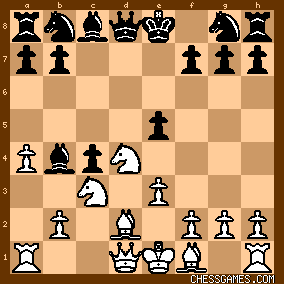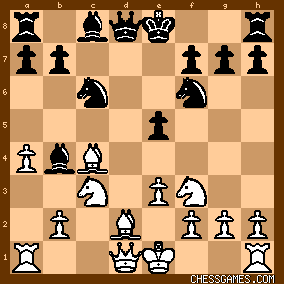| KEG: An exciting game with a disappointing and premature conclusion. Pillsbury's daring sacrifice of a pawn led to fascinating complications. This was a true positional sacrifice, and Pillsbury never recovered the pawn he lost on move 12. The question throughout the game was whether the Queen-side pressure and harassing of Burn's Queen were sufficient compensation. As Burn slowly improved his chances and reached a position by move 30 in which he seemed to have excellent winning prospects, the score ends (the balance allegedly being illegible) and the game was reportedly drawn shortly after move 30. By drawing this 11th round game, Pillsbury fell a half-point behind Schlechter and into a tie with Maroczy with four rounds to go (counting Schlechter's 11th round game against Halprin--for which the score also seems to break off--as a win for him). For Burn the draw left him a full point behind Marco in their battle for fourth place with four rounds to go (and only a half-point ahead of the charging Berger, who had won three in a row). 1. d4 d5
2. c4 e6
3. Nc3 c6
As <offramp> has aptly noted, Pillsbury's handling of the Black side of this Semi-Slav opening shows he was "way ahead of his time." What a pity Pillsbury died young and never played a match against Lasker. 4. Nf3 dxc4
4...Nf6 is solid, but Pillsbury obviously knew what he was doing. 5. a5
"!"--(Tournament Book), (Sergeant-Watts--in their book on the games of Pillsbury). "If 5. e3 b5" (Sergeant-Watts)
5... Bb4
5...Nf6 is also good (as is 5...c5), but Pillsbury, as usual, opted for the most complicated and aggressive variation. 6. Bd2
6. e3 is most usual here (and is the only move considered in MCO-13). The text, however, can also yield White some advantage and has been played by the likes of Gligoric, Euwe, and Lobron. 6... c5
Again selecting the most aggressive line. 6...Nf6 is solid and good here. 7. e3
7. cxd5 was probably best, but the text is also fine. 7... cxd4
7...Nf6 was also good. The text put the question to Burn: accept an isolated d-pawn or keep his d2 Bishop locked in by his pawn on e3 for a bit. Burn chose the latter option. 8. Nxd4 e5
Still going for the gold. 8...Nf6 was probably soundest, but Pillsbury probably already had his pawn sacrifice in mind, the position now being: 
click for larger view9. Nf3
9. Nc2 looks better, but Burn may have decided to accept the coming pawn sacrifice by Pillsbury. 9... Nc6
10. Bxc4 Nf6
The position was now:

click for larger view11. Qb3
"!"--(Tournament Book)(Sergeant Watts)
This leads to the pawn sacrifice Pillsbury was obviously planning and a tough tactical struggle. Simpler and at least arguably better (especially against a tactical genius such as Pillsbury) were 11. Qc2, 11. Nb5 or 11. h3, all of which lead to approximate equality. 11... 0-0!
11...Qe7 would save the pawn, but was hardly in Pillsbury's style. The sacrifice offered with the text was far-sighted but probably sound, as the continuation suggests. 12. Nxe5
"White now gains a pawn but his Queen is in consequence considerably harassed." (Sergeant-Watts). 12. 0-0 or 12. Rd1 were perhaps safer, but by this point Burn had undoubtedly decided to take the offered pawn and deal with the coming attack. 12... NxN
13. QxB
The position was now:

click for larger viewBattle lines were now in place. As I will discuss in my next post on this game, the subsequent play provided insight on the extent to which Pillsbury's pawn sacrifice was justified. | 




































